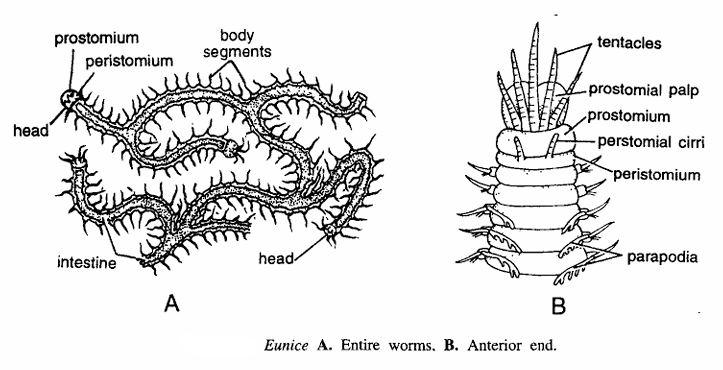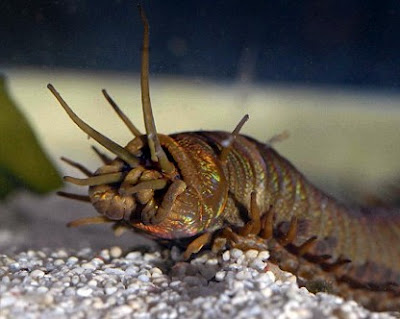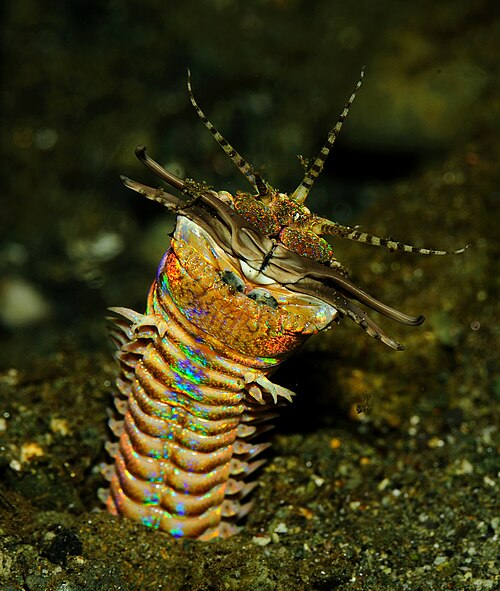Eunice: Morphology, Classification, Habitat, Life Cycle, and Ecological Significance of the Marine Polychaete Worm
Eunice is a genus of marine polychaete worms belonging to the family Eunicidae. These worms are renowned for their often large size, vigorous predatory behavior, and remarkable morphological features that have earned them nicknames such as the Bobbit worm. Species of Eunice inhabit a broad range of marine substrates from shallow coral reefs to deep-sea environments. Their role as apex invertebrate predators and their fascinating reproductive biology make Eunice an important genus in marine biological research.
Classification of Eunice
| Taxonomic Level | Name | Characteristics |
|---|---|---|
| Kingdom | Animalia | Multicellular organisms with specialized tissues |
| Phylum | Annelida | Segmented coelomate worms exhibiting metamerism |
| Class | Polychaeta | Marine bristle worms with parapodia bearing setae |
| Order | Eunicida | Polychaetes with strong jaws and complex parapodia |
| Family | Eunicidae | Large predatory polychaetes with powerful eversible pharynx |
| Genus | Eunice | Marine polychaetes, often giant worms with compound jaws |

Habit and Habitat
Eunice species are carnivorous and predominantly benthic, residing in burrows or crevices within sandy or rocky substrates, coral reefs, or coral rubble. They are active hunters known to ambush prey such as fish, mollusks, and other smaller invertebrates. Some giant species, like Eunice aphroditois, can grow up to several meters in length, enabling them to overpower larger prey. Eunice worms are typically nocturnal, retreating to burrows during the day. Their habitats range from intertidal zones to considerable oceanic depths, reflecting their adaptability to diverse marine conditions.
Geographical Distribution
The genus Eunice boasts a cosmopolitan distribution, found in temperate and tropical oceans worldwide. They are especially common in the Indo-Pacific region, including the Great Barrier Reef, as well as parts of the Atlantic Ocean. Their presence spans shallow coastal waters to offshore deep-sea habitats. Some species have been documented in Mediterranean and Caribbean seas as well.

General Characteristics
- Commonly called as palolo worm.
- The body of the animal is differentiated into anterior sexless atoke and posterior sexual part, the epitoke.
- Pigmentation is brownish or yellowish. Fully mature, gonad-laden epitokes project from the burrow, detach from atokes and swim independently on the surface of the sea, while the atokes regenerate new epitokes.
- Body elongated with numerous segments; peristomium consists of two segments with 1 pair of cirri, 5 tentacles and a large palp. Gills begin on sixth segments.
- During swarming, the ocean becomes full of these frenzied creatures, swimming at high speed with intense agitation.
- After spawning, the epitokes sink to bottom.
- In some localities the ova and spenns are in such enonnous number that the surface of the sea turns into a thick soup.
- Body Structure: Elongated and segmented with a strongly muscular body.
- Size: Variable, from a few centimeters to over 3 meters in giant species.
- Coloration: Generally ranges from reddish to brownish or iridescent hues.
- Head: Contains three antennae, a pair of palps, and strong mandibles and maxillae (jaws).
- Pharynx: Eversible and heavily armed with compound bidentate jaws used to capture and subdue prey.
- Parapodia: Well-developed, biramous, equipped with numerous chaetae or bristles for locomotion.
- Sensory Organs: Includes eyes and sensory palps enabling efficient environmental interaction.
- Respiratory System: Involves gills or body surface respiration, facilitated by well-vascularized parapodia.
- Reproduction: Dioecious; reproduces sexually with planktonic larval stages.
Special Features
- Palolo worm exhibits remarkable example of periodic reproduction. Over 90% of the population breeds within a single two-hour period of the entire year. The major swarm occurs in November during last quarter of moon when the low tide is unusually low.
- On the night of breeding posterior half twists counterclockwise, breaks, comes to surface, bursts, sheds sperms and ova and disintegrates. The local population collects them by netting and make into thick soup which tastes like spinach. The natives can predict when palolo would swarm and watch the sea daily.
- Powerful Eversible Jaws: Eunice’s jaws are a distinctive adaptation for predation, often strong enough to sever prey or deter predators.
- Large Size & Strength: Giant species have exceptional burrowing abilities and prey capture mechanisms.
- Rapid Regeneration: Like many polychaetes, Eunice exhibits remarkable regenerative capabilities for lost or damaged segments.
- Complex Sensory Apparatus: Enhanced sensory input aids nocturnal hunting and navigation.
- Epitoke Formation: Some species undergo epitokous transformation during reproduction, forming pelagic reproductive individuals.
- Burrowing Behavior: Eunice constructs extensive burrows that aid in sediment aeration and nutrient cycling.

Identification
Eunice species can be identified by:
- Strongly developed compound bidentate jaws visible upon pharynx eversion.
- Presence of three prominent antennae and paired palps on the head.
- Large body size and muscular segments with densely packed chaetae.
- Color patterns and ornamentation of parapodia.
- Morphological traits of subacicular hooks and branchial filaments.
- DNA barcoding and phylogenetic analyses supplement morphological classification.
Life Cycle
Eunice worms reproduce sexually with separate sexes. Spawning typically involves the release of gametes into water, often synchronized in mass swarming events linked to lunar cycles (epitoky). Fertilized eggs develop into free-swimming trochophore larvae, which undergo metamorphosis into juvenile worms resembling adults. Larvae settle onto substrates, grow, and mature into reproductive adults. Some species produce giant epitokes that rise to the surface and participate in reproductive swarms, which is a spectacular and ecologically important phenomenon.
Ecological Role and Importance
- Predation: Eunice worms serve as significant benthic predators, influencing population dynamics of prey species.
- Sediment Engineering: Their burrowing activity promotes oxygenation and nutrient cycling in marine sediments.
- Food Web Contribution: Serving as prey for some fish and larger invertebrates, Eunice links trophic levels.
- Biomedical Research: The regenerative capabilities and unique biochemistry of Eunice have implications in medical and scientific studies.
- Indicator Species: Changes in Eunice population densities may reflect environmental disturbances.
References
- https://zookeys.pensoft.net/article/86448/
- https://www.sciencedirect.com/science/article/pii/S0272771422001585
- https://pmc.ncbi.nlm.nih.gov/articles/PMC9848632/
- https://en.wikipedia.org/wiki/Eunicidae
- https://www.sealifebase.ca/summary/Eunice-aphroditois.html
- https://repository.si.edu/bitstreams/f55fc157-7ee8-4f08-af47-b173bc1e44c2/download
- https://tropicalstudies.org/rbt/attachments/volumes/vol59-4/02_Salazar_Giant_Eunicid_Polychaetes.pdf
- https://pmc.ncbi.nlm.nih.gov/articles/PMC7124122/
- https://repository.si.edu/bitstream/handle/10088/6302/SCtZ-0523-Lo_res.pdf?sequence=2&isAllowed=y
- https://microbenotes.com/wuchereria-bancrofti-habitat-morphology-and-life-cycle/
- https://mindmapai.app/mind-mapping/nematodes
- https://zookeys.pensoft.net/article/23088/
